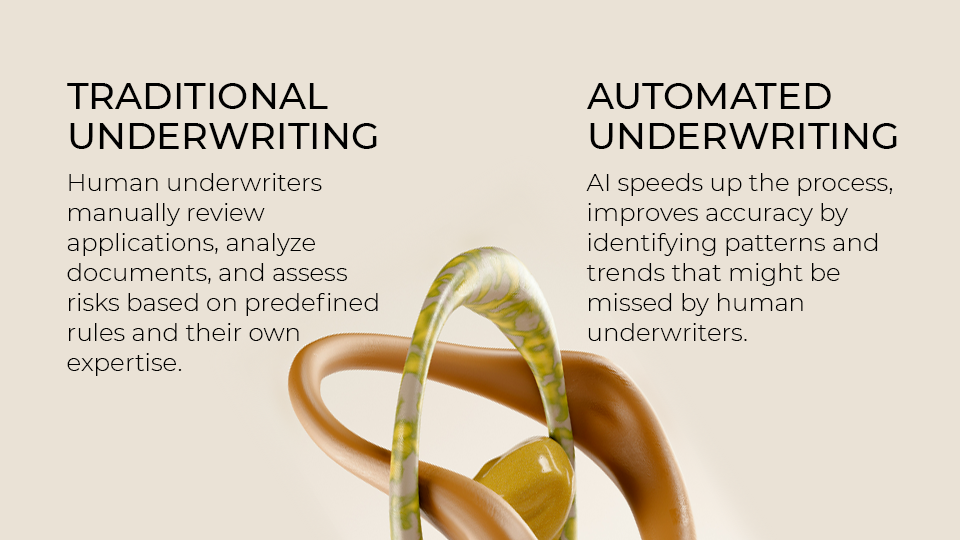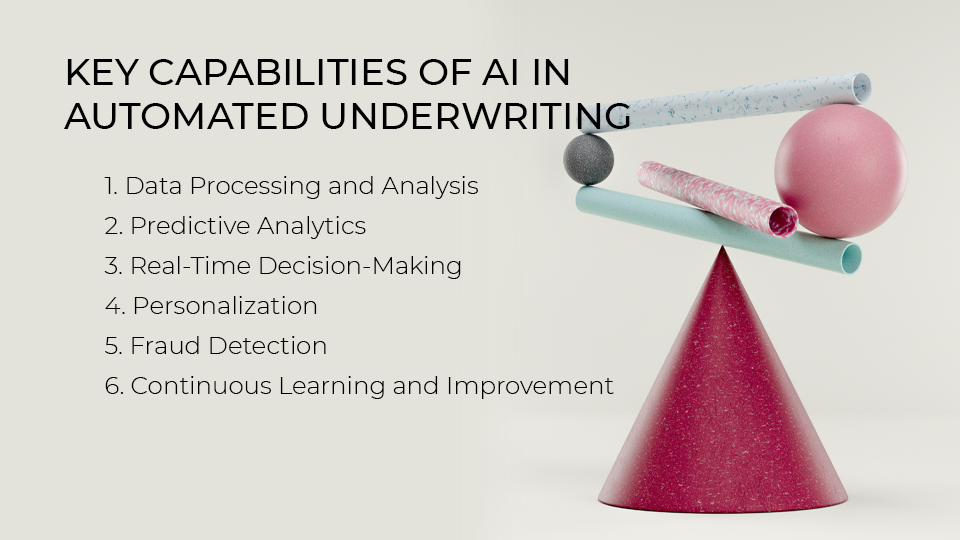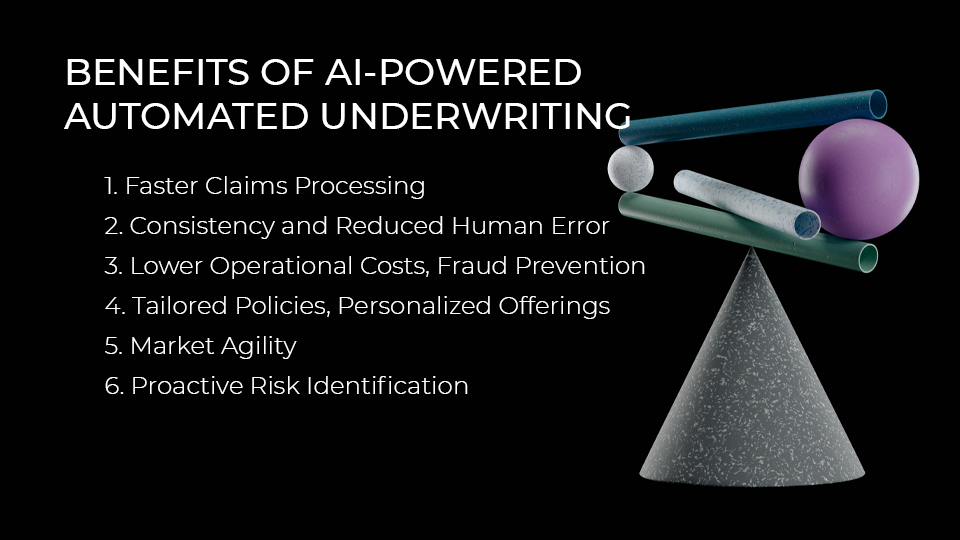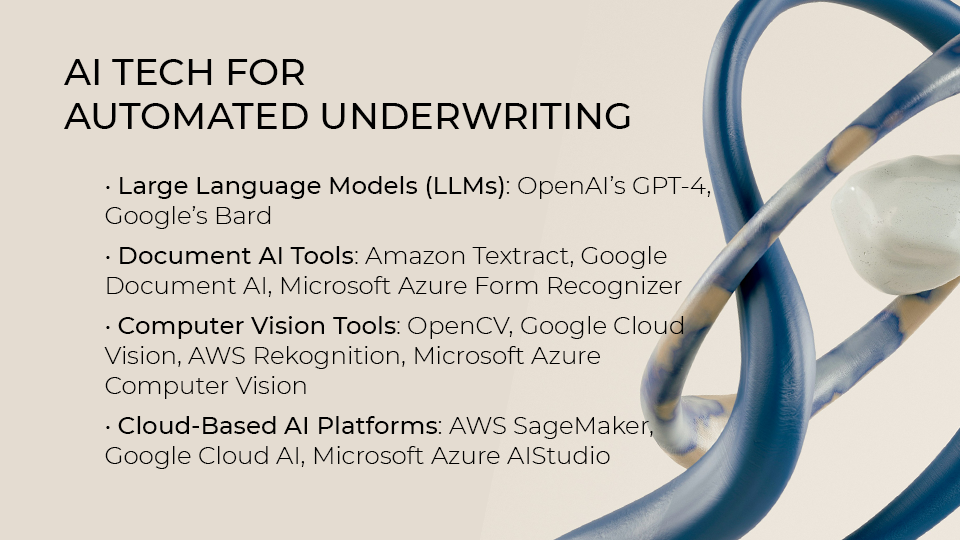The insurance industry is undergoing a seismic shift, driven by the rapid adoption of artificial intelligence (AI). According to a recent report by McKinsey, AI technologies could potentially generate up to $1.1 trillion in value for the insurance sector by 2030. At the heart of this transformation lies automated underwriting—a process that is being revolutionized by AI to make it faster, more accurate, and cost-effective.
Underwriting, the backbone of insurance operations, involves assessing risks and determining the terms of coverage. Traditionally, this has been a manual, time-intensive process prone to human error and inefficiencies. Enter AI-powered automated underwriting: a game-changing approach that leverages advanced algorithms, machine learning, and data analytics to streamline decision-making, enhance precision, and deliver personalized insurance solutions at scale.
Looking for AI developers?
We create AI software — and we do it well. Talk to us to get your project started today
In this guide, we’ll explore how AI is reshaping the underwriting landscape, the key capabilities it brings to the table, and why insurers are increasingly turning to automation to stay competitive in a digital-first world. Whether you’re an industry professional or simply curious about the future of insurance, this article will provide valuable insights into the transformative power of AI in automated underwriting.
What is Automated Underwriting?
At its core, automated underwriting is the use of technology to evaluate and process insurance applications with minimal human intervention. It’s a system designed to assess risk, determine eligibility, and calculate premiums quickly and efficiently. But what sets it apart from traditional underwriting is its reliance on advanced technologies, particularly artificial intelligence (AI), to make data-driven decisions in real time.
Traditional Underwriting vs. Automated Underwriting
In the traditional underwriting process, human underwriters manually review applications, analyze documents, and assess risks based on predefined rules and their own expertise. While effective, this approach is often slow, labor-intensive, and susceptible to human error. It also struggles to handle large volumes of applications, especially in today’s fast-paced digital environment.

Automated underwriting, on the other hand, replaces much of this manual effort with AI-powered systems. These systems can process vast amounts of data—from medical records and financial histories to social media activity and IoT device inputs—in a matter of seconds. By leveraging machine learning algorithms, automated underwriting not only speeds up the process but also improves accuracy by identifying patterns and trends that might be missed by human underwriters.
The Role of AI in Automated Underwriting
AI is the engine that powers automated underwriting, enabling it to perform tasks that were once thought to require human judgment. Here’s how AI transforms the underwriting process:
- Data Integration: AI systems can pull data from multiple sources, including internal databases, third-party providers, and even unstructured data like text or images.
- Risk Assessment: Machine learning models analyze historical data to predict risks and outcomes, allowing insurers to make more informed decisions.
- Real-Time Processing: AI enables instant evaluation of applications, reducing wait times for customers and improving overall satisfaction.
- Continuous Learning: Unlike static rule-based systems, AI models improve over time as they process more data, leading to increasingly accurate underwriting decisions.
In essence, automated underwriting powered by AI is not just about replacing humans—it’s about enhancing the entire process, making it smarter, faster, and more scalable. As we delve deeper into the capabilities of AI in the next section, you’ll see how this technology is redefining what’s possible in the world of insurance underwriting.
Key AI Capabilities in Automated Underwriting
Artificial intelligence is the cornerstone of modern automated underwriting, bringing a suite of advanced capabilities that transform how insurers assess risk, make decisions, and interact with customers. Here are the key AI capabilities driving this revolution:

1. Data Processing and Analysis
AI excels at handling massive volumes of data—both structured (e.g., financial records, credit scores) and unstructured (e.g., medical notes, social media activity). Using techniques like natural language processing (NLP), AI can extract meaningful insights from text-based data, such as doctor’s notes or customer emails, which were previously difficult to analyze at scale. This allows insurers to build a more comprehensive risk profile for each applicant.
2. Predictive Analytics
One of AI’s most powerful features is its ability to predict outcomes based on historical data. Machine learning algorithms analyze patterns and trends to forecast risks, such as the likelihood of a claim being filed or the potential for fraud. For example, an AI model might identify that applicants with certain lifestyle habits are more likely to file health insurance claims, enabling insurers to adjust premiums or coverage terms accordingly.
3. Real-Time Decision-Making
Gone are the days of waiting weeks for an underwriting decision. AI-powered systems can evaluate applications and provide instant decisions, often in a matter of seconds. This not only improves operational efficiency but also enhances the customer experience, as applicants no longer need to endure lengthy waiting periods.
4. Personalization
AI enables hyper-personalized underwriting by tailoring policies to individual risk profiles. By analyzing a wide range of data points—from demographic information to behavioral data—AI can create customized insurance products that better meet the needs of each customer. For instance, a life insurance policy might be adjusted based on an applicant’s fitness tracker data, offering lower premiums for healthier lifestyles.
5. Fraud Detection
Fraud is a significant challenge in the insurance industry, costing billions annually. AI helps combat this by identifying suspicious patterns or anomalies in applications. Machine learning models can flag high-risk cases for further review, such as inconsistencies in medical records or unusual financial behavior, reducing the likelihood of fraudulent claims.
6. Continuous Learning and Improvement
Unlike traditional rule-based systems, AI models improve over time. Through reinforcement learning, these systems continuously refine their algorithms as they process more data, leading to increasingly accurate and reliable underwriting decisions. This self-improving capability ensures that AI-powered underwriting systems stay ahead of evolving risks and market trends.
Benefits of AI-Powered Automated Underwriting
The integration of AI into underwriting processes is not just a technological upgrade—it’s a strategic transformation that delivers significant advantages for insurers, customers, and the industry as a whole. Here are the key benefits of AI-powered automated underwriting:

1. Enhanced Efficiency
- Faster Processing: AI systems can evaluate applications and provide underwriting decisions in real time, reducing processing times from weeks to seconds.
- Reduced Workload: By automating repetitive and time-consuming tasks, AI frees up human underwriters to focus on complex cases that require expert judgment.
- Scalability: Insurers can handle a higher volume of applications without needing to proportionally increase their workforce, making it easier to scale operations during peak periods.
2. Improved Accuracy
- Data-Driven Decisions: AI analyzes vast amounts of data to identify patterns and trends, leading to more accurate risk assessments and pricing.
- Reduced Human Error: Automation minimizes the risk of mistakes that can occur in manual underwriting processes, such as miscalculations or overlooked details.
- Consistency: AI ensures that underwriting decisions are consistent and unbiased, as they are based on predefined algorithms rather than subjective judgment.
3. Cost Savings
- Lower Operational Costs: By automating routine tasks, insurers can reduce labor costs and operational expenses.
- Fraud Prevention: AI’s ability to detect fraudulent applications early in the process helps insurers avoid costly payouts and legal disputes.
- Optimized Resource Allocation: With AI handling the bulk of underwriting, companies can allocate resources more effectively, focusing on high-value activities.
4. Superior Customer Experience
- Instant Decisions: Customers no longer have to wait weeks for underwriting outcomes, leading to faster policy issuance and higher satisfaction.
- Personalized Offerings: AI enables insurers to tailor policies to individual needs, offering more relevant and competitive products.
- Seamless Interactions: Automated underwriting integrates seamlessly with digital platforms, providing a smooth and user-friendly experience for customers.
5. Competitive Advantage
- Innovation Leadership: Insurers that adopt AI-powered underwriting position themselves as forward-thinking and technologically advanced, attracting tech-savvy customers.
- Market Agility: AI allows insurers to quickly adapt to changing market conditions, regulatory requirements, and customer expectations.
- Data Monetization: The insights generated by AI can be used to develop new products, enter new markets, or improve existing offerings, creating additional revenue streams.
6. Better Risk Management
- Proactive Risk Identification: AI’s predictive analytics capabilities enable insurers to identify and mitigate risks before they materialize.
- Dynamic Pricing: Insurers can adjust premiums in real time based on evolving risk factors, ensuring fair and accurate pricing.
- Compliance Assurance: AI systems can be programmed to adhere to regulatory requirements, reducing the risk of non-compliance and associated penalties.
7. Empowerment of Human Underwriters
- Focus on Complex Cases: By automating routine tasks, AI allows human underwriters to concentrate on high-value, complex cases that require nuanced decision-making.
- Enhanced Decision Support: AI provides underwriters with data-driven insights and recommendations, improving the quality of their decisions.
- Skill Development: Underwriters can upskill and transition into roles that require strategic thinking and advanced analytical capabilities.
Challenges and Considerations in AI-Powered Automated Underwriting
While AI-powered automated underwriting offers immense benefits, it’s not without its challenges. Implementing AI in underwriting requires careful planning, robust infrastructure, and a clear understanding of potential pitfalls. Here are the key challenges and considerations insurers must address to successfully adopt AI-driven underwriting:
1. Data Quality and Availability
Challenge: AI models rely on high-quality, accurate, and diverse data to make reliable decisions. Poor data quality—such as incomplete, outdated, or biased data—can lead to flawed underwriting outcomes.
Solution: Insurers must invest in data cleansing, validation, and enrichment processes to ensure their AI systems have access to reliable data. Additionally, they should explore partnerships with third-party data providers to fill gaps in their datasets.
2. Regulatory Compliance
Challenge: The insurance industry is heavily regulated, and AI systems must comply with laws related to data privacy, fairness, and transparency (e.g., GDPR, HIPAA, or local insurance regulations).
Solution: Insurers need to work closely with legal and compliance teams to ensure their AI models adhere to regulatory requirements. This includes implementing mechanisms for auditing and explaining AI decisions.
3. Explainability and Transparency
Challenge: Many AI models, particularly deep learning systems, operate as "black boxes," making it difficult to understand how they arrive at specific decisions. This lack of transparency can be a barrier to trust and adoption.
Solution: Insurers should prioritize explainable AI (XAI) techniques that provide clear, interpretable insights into decision-making processes. This not only builds trust with customers but also helps regulators and underwriters understand and validate AI outcomes.
4. Bias and Fairness
Challenge: AI models can inadvertently perpetuate or amplify biases present in the training data, leading to unfair or discriminatory underwriting decisions.
Solution: Insurers must implement fairness checks and bias mitigation strategies during model development. Regularly auditing AI systems for bias and ensuring diverse, representative datasets can help promote fairness.
5. Integration with Legacy Systems
Challenge: Many insurers still rely on outdated legacy systems that may not be compatible with modern AI technologies, creating integration hurdles.
Solution: A phased approach to implementation, starting with pilot projects, can help insurers gradually modernize their infrastructure. APIs and middleware can also bridge the gap between legacy systems and AI platforms.
6. Cybersecurity Risks
Challenge: AI systems process sensitive customer data, making them potential targets for cyberattacks. A breach could compromise customer privacy and damage the insurer’s reputation.
Solution: Robust cybersecurity measures, such as encryption, access controls, and regular vulnerability assessments, are essential to protect AI systems and the data they handle.
7. Change Management
Challenge: The adoption of AI-powered underwriting requires a cultural shift within organizations. Employees may resist change due to fear of job displacement or lack of understanding about AI.
Solution: Insurers should invest in change management initiatives, including training programs to upskill employees and clear communication about the benefits of AI. Emphasizing AI as a tool to augment—not replace—human underwriters can ease the transition.
8. Cost of Implementation
Challenge: Developing and deploying AI systems can be expensive, requiring significant investment in technology, talent, and infrastructure.
Consideration: Consider starting with a prototype to test the viability of your project and get a preliminary system without significant investments.
Describe your idea and get an estimation for your AI project
AI Technologies Powering Automated Underwriting

Large Language Models (LLMs)
Examples: OpenAI’s GPT-4, Google’s Bard, Anthropic’s Claude, Cohere.
What They Do
LLMs are advanced AI systems trained on massive datasets of text, enabling them to understand, generate, and interact with human language in a highly sophisticated way. They excel at tasks like text generation, summarization, translation, and question-answering.
Applications in Automated Underwriting
- Policy Document Generation: LLMs can automatically create personalized policy documents tailored to individual customer profiles. For example, they can generate life insurance policies based on medical history or auto insurance policies based on driving records.
- Customer Communication: LLMs can draft emails, FAQs, and other communications, ensuring consistent and clear messaging. They can also explain underwriting decisions in plain language, improving transparency and customer trust.
- Data Extraction and Summarization: LLMs can parse lengthy documents, such as medical records or legal agreements, to extract key information. For instance, they can summarize a 50-page medical report into a concise risk assessment for underwriters.
- Chatbots and Virtual Assistants: LLMs power intelligent chatbots that guide customers through the application process, answer questions, and provide real-time support, enhancing the customer experience.
LLMs reduce manual effort, improve efficiency, and enable insurers to handle unstructured data at scale. They also enhance customer interactions by providing quick, accurate, and personalized responses.
Document AI Tools
Examples: Amazon Textract, Google Document AI, Microsoft Azure Form Recognizer, IBM Datacap.
What They Do
Document AI tools use machine learning and natural language processing to extract text, data, and insights from scanned documents, PDFs, and images. They can recognize handwriting, tables, and forms, converting unstructured data into structured formats.
Applications in Automated Underwriting
- Data Extraction: These tools can automatically extract information from application forms, IDs, invoices, and financial statements. For example, they can pull income data from tax documents or medical history from health records.
- Document Classification: Document AI tools can categorize documents, such as separating medical records from financial statements, streamlining the underwriting workflow.
- Fraud Detection: By analyzing inconsistencies in documents, such as mismatched signatures or altered text, these tools can flag potential fraud.
- Automated Data Entry: Document AI eliminates the need for manual data entry by directly inputting extracted data into underwriting systems, reducing errors and saving time.
Document AI tools significantly reduce the time and effort required to process paperwork, enabling faster underwriting decisions. They also improve accuracy by minimizing human error and ensuring data consistency.
Computer Vision Tools
Examples: OpenCV, Google Cloud Vision, AWS Rekognition, Microsoft Azure Computer Vision.
What They Do
Computer vision enables machines to analyze and interpret visual data, such as images and videos. It can recognize objects, detect patterns, and extract text from visual content.
Applications in Automated Underwriting
- Damage Assessment: In auto or property insurance, computer vision can analyze photos of damaged vehicles or homes to estimate repair costs. For example, it can assess the severity of a car accident or the extent of storm damage to a roof.
- Identity Verification: Computer vision can verify the authenticity of identity documents, such as passports or driver’s licenses, by analyzing security features and comparing them to known templates.
- Text Extraction from Images: Tools like AWS Textract or Google Cloud Vision can extract text from handwritten forms, scanned documents, or even photos of whiteboards, making it easier to process unstructured data.
- Fraud Detection: Computer vision can detect tampered or forged documents by analyzing visual inconsistencies, such as altered text or mismatched fonts.
Computer vision tools enhance the accuracy and efficiency of underwriting by automating visual data analysis. They also enable insurers to handle claims and applications that rely on visual evidence, such as photos or scanned documents.
Cloud-Based AI Platforms
Examples: AWS SageMaker, Google Cloud AI, Microsoft Azure AI, IBM Watson Studio.
What They Do
Cloud-based AI platforms provide scalable infrastructure and tools for building, training, and deploying AI models. They offer pre-built algorithms, data storage, and processing capabilities, making it easier for organizations to implement AI solutions.
Applications in Automated Underwriting
- Model Development and Training: These platforms provide tools for building and training machine learning models, such as risk prediction or fraud detection algorithms. For example, insurers can use AWS SageMaker to develop models that predict the likelihood of claims based on historical data.
- Data Storage and Processing: Cloud platforms offer scalable storage solutions for large datasets, such as customer profiles, claims history, and IoT data. They also provide tools for cleaning, transforming, and analyzing this data.
- Real-Time Decision-Making: Cloud-based AI platforms enable real-time underwriting decisions by deploying models that can process applications instantly. For instance, an auto insurer can use Google Cloud AI to evaluate driving behavior data from telematics devices in real time.
- Integration with Other Systems: Cloud platforms allow seamless integration with existing underwriting systems, CRMs, and IoT devices, ensuring a smooth flow of data across the organization.
Cloud-based AI platforms provide the scalability, flexibility, and computational power needed to implement AI-driven underwriting at scale. They also reduce the need for costly on-premise infrastructure, making AI accessible to insurers of all sizes.
Why choose Businessware Technologies as your software development company?
- Businessware Technologies is a reliable AI development vendor: it has been recognised as one of the top software development companies by Clutch and Manifest, it is a Top Rated Plus agency Upwork, and has received local awards for its excellent work,
- A team of over 70 highly skilled software engineers with extensive experience in developing complex software for both startups and Fortune 500 companies,
- Deep expertise in modern AI technologies and approaches to system development, like data science, machine learning, OpenCV, Python, Tesseract, and many more,
- Businessware Technologies is a Microsoft Gold Certified partner,
- Businessware Technologies is compliant with GDPR, ISO 9001, ISO 27001 standards,
- Businessware Technologies works with Fortune 500 companies and has had decades-long relationships with most of its clients,
- Businessware Technologies has proven to be a reliable AI outsourcing partner by having an excellent track record in AI and ML development backed by an extensive portfolio of successful projects.
If you have an AI project in mind and need help with implementation, contact our manager and they will be happy to help you.